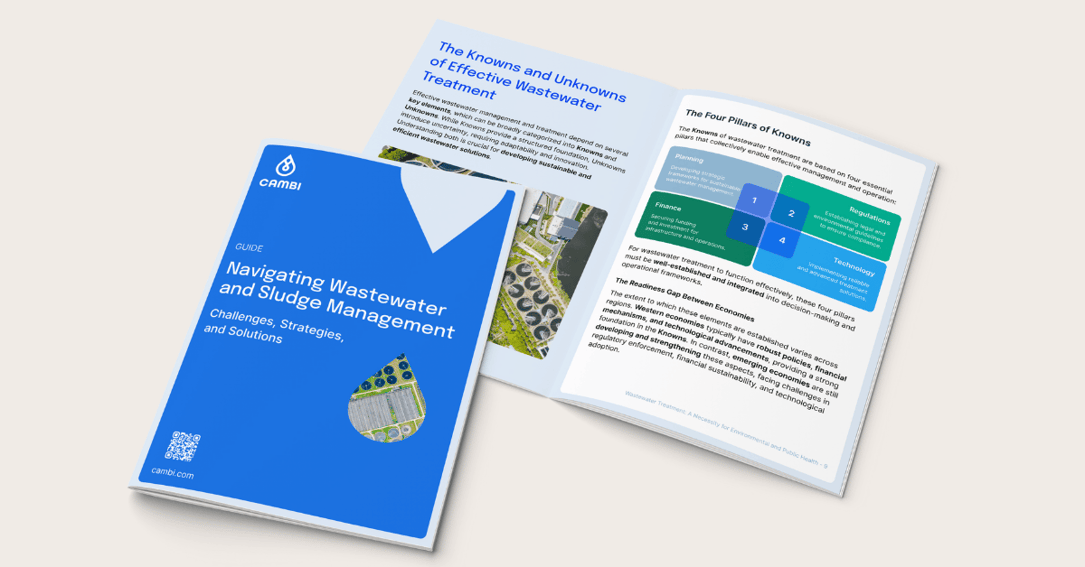Navigating Wastewater Management: A Whitepaper Preview
Get to know the key pillars, risks, and strategies for resilient wastewater management in this Cambi whitepaper.

newsletter
Cambi’s new whitepaper, Navigating Wastewater and Sludge Management: Challenges, Strategies, and Solutions, offers a practical guide to the complex world of wastewater treatment projects. It explores the critical pillars of project success, highlights the hidden pitfalls that can derail progress, and outlines a step-by-step roadmap for building resilient wastewater management strategies.
This preview provides a glimpse into the insights and frameworks featured in the publication.
Wastewater Management and Treatment
Managing wastewater is a complex, multi-faceted challenge involving many stakeholders and technical processes. The Cambi whitepaper makes an important distinction between wastewater management and wastewater treatment, the two interdependent aspects of this challenge:
- Management – the planning, strategy, and operational oversight needed to handle wastewater and sludge sustainably.
- Treatment – the technical processes, using physical, chemical, and biological methods, to remove pollutants from water.
By investing in organized wastewater management and modern treatment techniques, communities can prevent waterborne diseases, protect fisheries and agriculture, and maintain clean water resources for future use.
The effectiveness of wastewater management and treatment depends on navigating Known and Unknown factors.
The “Knowns” of Wastewater Treatment: Four Pillars for Effective Operation
In the whitepaper, Cambi outlines the “Knowns” - established pillars that enable reliable wastewater management and operations:

- Regulations: A clear regulatory framework is the first pillar. This means strong laws and environmental guidelines that enforce proper wastewater practices.
- Planning: Effective management requires strategic planning for sustainable wastewater systems. Long-term master plans, capacity assessments, and growth-aligned strategies fall under this pillar.
- Technology: Wastewater must be treated with reliable, advanced processes – from biological treatment tanks to sludge treatment methods and energy recovery solutions. Having the right technical solutions in place ensures that contaminants are effectively removed and that operations run efficiently.
- Finance: This encompasses everything from securing sustainable funding and investment for wastewater projects, budgeting for construction, upgrades, and operations. This pillar also includes the tariffs, fees, and grants that affect a utility’s economic sustainability.
These four “known” elements provide structure and predictability to wastewater projects. Regions with mature water sectors usually have well-established regulations, solid funding mechanisms, and access to technology – giving them a strong foundation in the known pillars.
In contrast, emerging economies may still be developing these aspects, facing gaps in enforcement, financing, or tech adoption. Recognizing where a project stands on these fundamentals is important, as it highlights strengths to leverage and weaknesses to address.
The “Unknowns” of Wastewater Treatment: Complex Challenges and Uncertainties
While the known pillars provide the foundation of every successful wastewater project, the “unknowns” are the variables and challenges that introduce complexity and uncertainty.
The Cambi whitepaper identifies several key unknowns that can pose obstacles to wastewater treatment success:

- Missing Drivers or Incentives: Sometimes the market and policy drivers for wastewater projects are weak or unclear, reducing momentum. For example, if there are no strong mandates or financial incentives for improving treatment, projects may stall. Unclear market incentives and inconsistent enforcement can sap the urgency needed to invest in better facilities.
- Regulatory Gaps: Even where regulations exist, they might be outdated or weakly enforced. Delayed updates to standards or inconsistent enforcement can lead to confusion and uneven compliance.
- Financial Constraints: Limited funding is a very common challenge, especially in developing regions. Wastewater infrastructure is expensive – if municipalities or utilities lack access to stable financing, needed upgrades and maintenance can be delayed. Financial shortfalls can also hinder research into new treatment methods or the expansion of service coverage.
- Emerging Contaminants: Water quality is a moving target. New pollutants like microplastics, pharmaceutical residues, and PFAS chemicals are being detected, and treatment solutions for them are still evolving. These emerging contaminants may require new technologies or stricter regulations that current systems aren’t prepared for.
- Evolving Environmental Conditions: Climate change and other environmental shifts are adding uncertainty to wastewater management. Changing rainfall patterns, extreme storms, and rising temperatures can all impact how treatment plants operate and how sewer systems perform. These evolving conditions force planners to adapt designs and emergency plans in ways that weren’t previously considered.
- Stakeholder Alignment Issues: Wastewater projects often involve a web of stakeholders – city governments, industries, residents, investors, regulators. Misalignment or poor communication among stakeholders is an “unknown” that can derail projects or cause delays, as each party may have different priorities or concerns.
All of these unknowns explain why wastewater management is challenging: even with the best-laid plans (the Knowns), one must expect the unexpected and be ready to adapt. Recognising uncertainties allows leaders to build in flexibility, conduct research, innovate, and collaborate across sectors to overcome the unknowns.
Critical Steps for Success in Wastewater and Sludge Management
After laying out the known pillars and unknown challenges, the Cambi whitepaper provides a roadmap for success in wastewater and sludge projects.

These three steps – establishing drivers, communicating clearly, and executing effectively – form a strategy that can greatly improve the chances of wastewater project success. These phases of execution are discussed at length in the publication.
To explore these strategies in detail and access practical insights, download the full whitepaper.
Nitrogen Recovery in Wastewater Treatment
Look into how economic incentives, stringent limits, and emerging technologies are shaping nitrogen recovery in wastewater treatment.
Dive inPhosphorus Recovery in Wastewater Treatment
Uncover why wastewater plants are recovering phosphorus, its role in fertiliser security, operational performance, key policies, and the global outlook.
Dive inThe Carbon Footprint of Wastewater Treatment Plants
Discover how wastewater treatment plants can reduce their carbon footprint through smart technologies and innovative sludge management practices.
Dive in